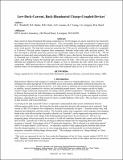Low-dark-current, back-illuminated charge-coupled-devices
Author(s)
Reich, Robert K.; Gregory, James A.; Young, Douglas J.; Loomis, Andrew H.; Clark, Harry R., Jr.; Burke, Barry E.; Westhoff, Richard C.; ... Show more Show less
DownloadWesthoff-2009-Low-dark-current, back-illuminated charge-coupled-devices.pdf (518.5Kb)
PUBLISHER_POLICY
Publisher Policy
Article is made available in accordance with the publisher's policy and may be subject to US copyright law. Please refer to the publisher's site for terms of use.
Terms of use
Metadata
Show full item recordAbstract
Dark current for back-illuminated (BI) charge-coupled-device (CCD) imagers at Lincoln Laboratory has historically been higher than for front-illuminated (FI) detectors. This is presumably due to high concentrations of unpassivated dangling bonds at or near the thinned back surface caused by wafer thinning, inadequate passivation and low quality native oxide growth. The high dark current has meant that the CCDs must be substantially cooled to be comparable to FI devices. The dark current comprises three components: frontside surface-state, bulk, and back surface. We have developed a backside passivation process that significantly reduces the dark current of BI CCDs. The BI imagers are passivated using molecular beam epitaxy (MBE) to grow a thin heavily boron-doped layer, followed by an annealing step in hydrogen. The frontside surface state component can be suppressed using surface inversion, where clock dithering reduces the frontside dark current below the bulk. This work uses surface inversion, clock dithering and comparison between FI and BI imagers as tools to determine the dark current from each of the components. MBE passivated devices, when used with clock dithering, have dark current reduced by a factor of one hundred relative to ion-implant/laser annealed devices, with measured values as low as 10-14 pA/cm[superscript 2] at 20°C.
Date issued
2009-01Department
Lincoln LaboratoryJournal
Proceedings of SPIE--the International Society for Optical Engineering
Publisher
Society of Photo-optical Instrumentation Engineers
Citation
Westhoff, R. C. et al. “Low dark current, back-illuminated charge coupled devices.” Sensors, Cameras, and Systems for Industrial/Scientific Applications X. Ed. Erik Bodegom & Valerie Nguyen. San Jose, CA, USA: SPIE, 2009. 72490J-11. © 2009 SPIE
Version: Final published version
ISSN
0277-786X